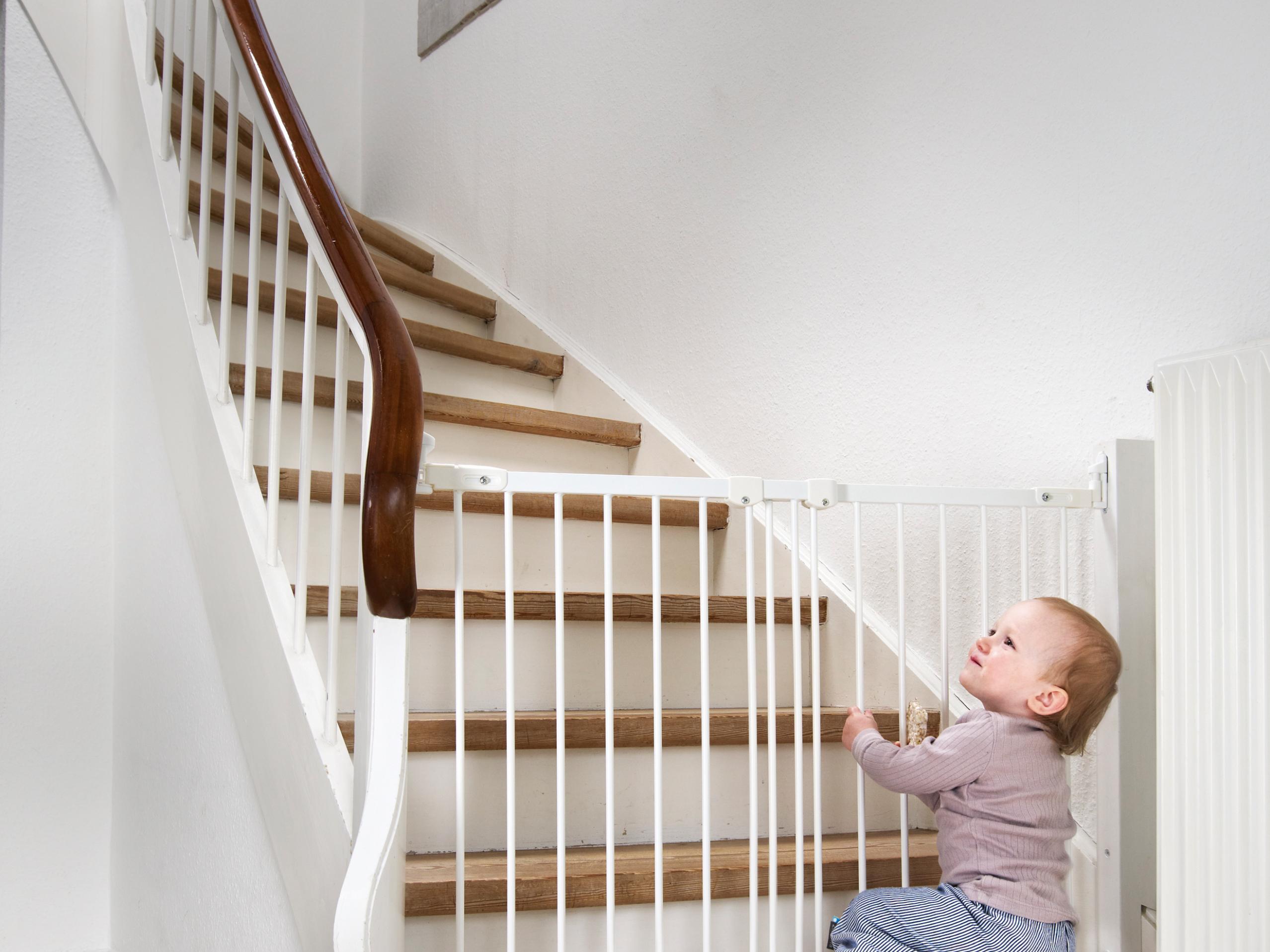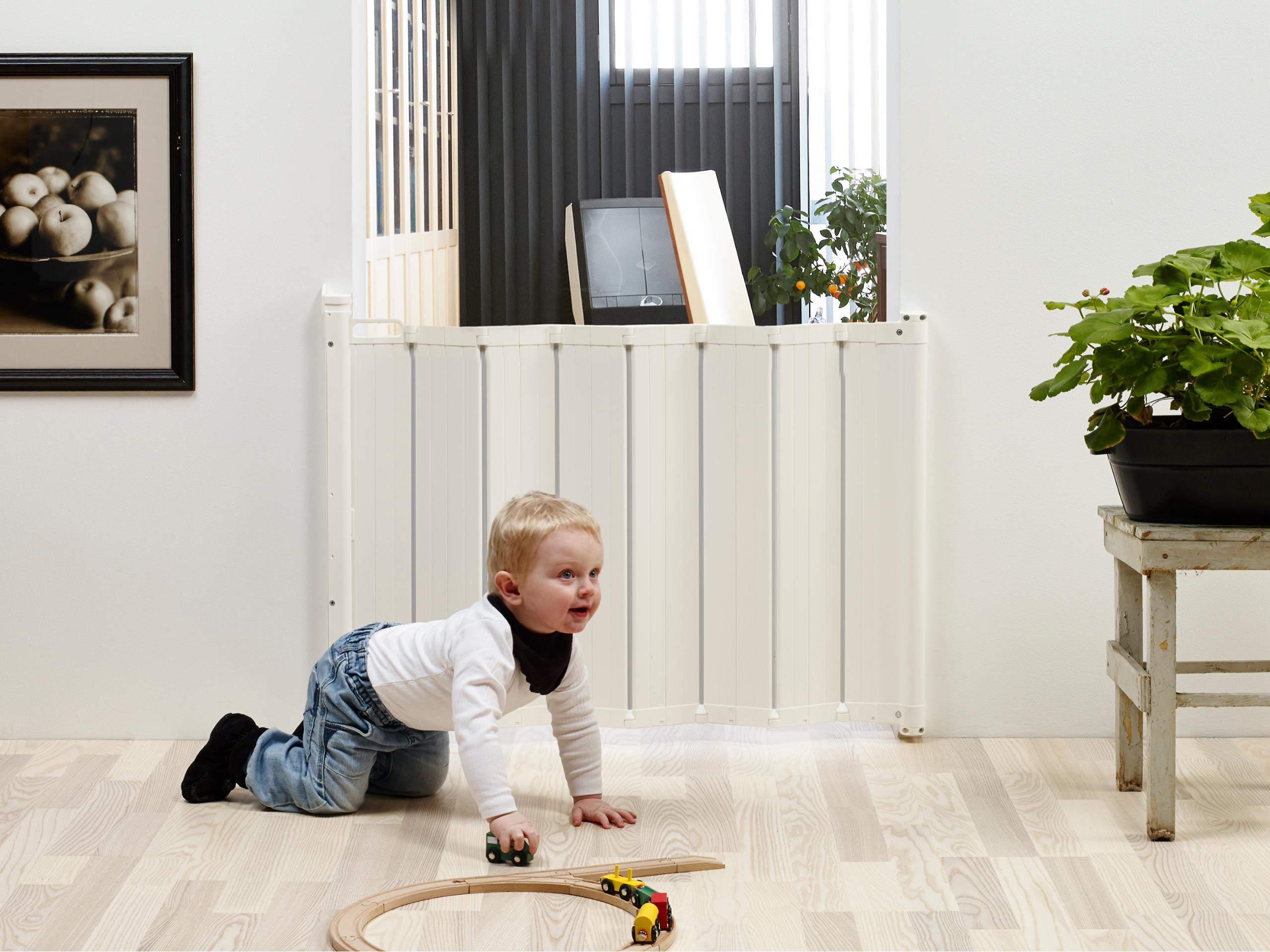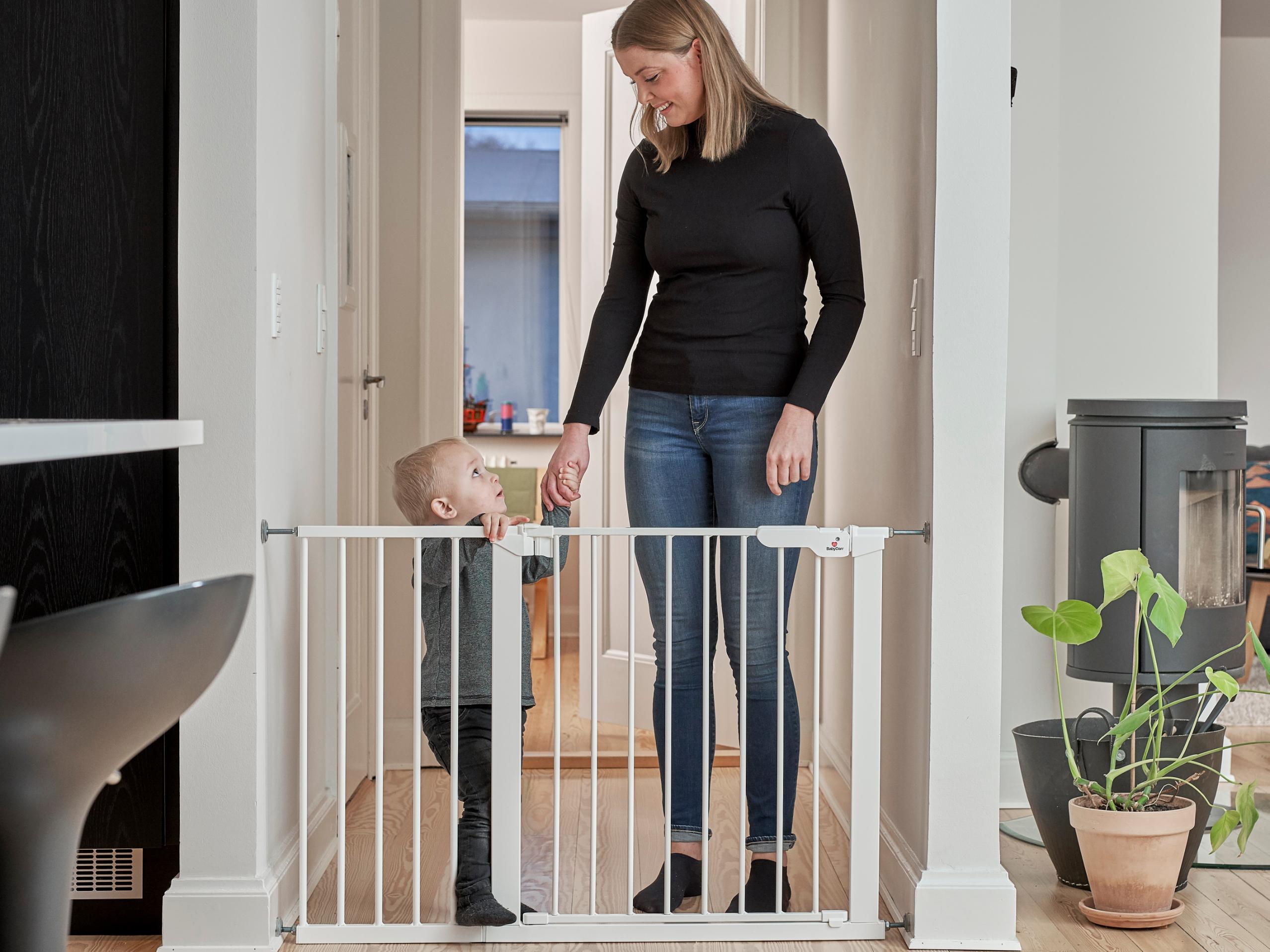BabyDan's two types of safety gates
There are pressure mounted and wall mounted safety gates, and it is important that you choose the right one in order to be sure that it is as safe as possible. However, what does it even mean, ‘pressure mounted’ and ‘wall mounted’? And why pick one and not the other?
It can be hard to determine which type of safety gate best fits your needs. Therefore, read on below, and learn more about what types of safety gates you can choose from and what they are each best suited for.
Why are there different kinds of safety gates?
At BabyDan, we have chosen to sell two different types of safety gates because different requirements need different kinds of safety gates. It makes a difference whether the safety gate is to be used to block a door, the end of a staircase, to divide a room or to prevent a child from touching a wood burning stove. This is why we have two different kinds of safety gates - we want to be sure that there is one for your specific requirements and we want the safety gate to offer the ideal level of protection for your child.
At BabyDan, we divide safety gates into two types: wall mounted safety gates and pressure mounted safety gates.

Wall mounted safety gates
With these safety gates, you will be installing a wall mounted safety gate using screws into a wall or door frame - thus the name, ‘wall mounted’.
Wall mounted safety gates can in principle be used anywhere in a home, but they are particularly well suited for the top of the stairs, for use as room dividers or to prevent access to a wood burning stove or a fireplace.
We recommend that you should always choose a wall mounted safety gate if you are installing it at the top of the stairs. We believe that this is the safest choice, even though pressure mounted safety gates have also been approved for use at the top of stairs.
Do you want to be able to move your wall mounted safety gate? No problem! You can buy extra wall fittings and install them in the areas of your home where you want to use the safety gate. That allows you to easily remove the safety gate from one set of fittings and click it in place on another set.
If, for example, you want to use the safety gate both at home and in your summerhouse, you can install fittings in both locations and take the safety gate with you where you need it. However, please keep in mind that the opening measurements must be similar in the places where you want to use your safety gate.
Our BabyDan OLAF and BabyDan Flex safety gates are all wall mounted and come in many different sizes. In fact, you can extend your BabyDan OLAF and BabyDan Flex pretty much indefinitely, meaning that you can get them to match your exact requirements.

Here is a list of all wall mounted safety gates:
BabyDan Flex add
BabyDan OLAF add
BabyDan ALMA add
BabyDan EBBA add
BabyDan ELIN add
BabyDan FlexiFit add
BabyDan Guard Me add
BabyDan LENA add
BabyDan MultiDan add
BabyDan No Trip add
BabyDan LIVA add
BabyDan SAGA add
BabyDan Premier with 3 extensions add
BabyDan Premier with 4 extensions add
BabyDan Premier with 5 extensions add
BabyDan Premier with 6 extensions add
Pressure mounted safety gates
A pressure mounted safety gate is tension mounted between two walls or inside a door frame. This means that you do not have to use screws or drill holes into the walls or the door frame. Even if the safety gate is in suspension, it leaves no marks.
You can use a pressure mounted safety gate in a door opening, in a corridor or at the bottom of a staircase. We do not recommend that you use a pressure mounted safety gate on top of the stairs - here you should instead use a wall mounted safety gate just to be completely sure that it will hold.
When installing a pressure mounted safety gate, it is important that you have the correct amount of tension holding it in place. In order to make it as easy as possible for you, the majority of BabyDan’s pressure mounted safety gates have an integrated safety indicator. It is in the form of a small red plastic stick that tells you if the safety gate is installed with the correct amount of tension. The safety indicator can be found between the handle and the safety gate.
If you have installed the safety gate correctly, you will not be able to spot the red indicator once you close the safety gate door. However, if you do see it, you will need to increase the tension on the safety gate, otherwise your child might be able to open it or run the risk of falling over it if leaning against it.

Some of our pressure mounted safety gates do not come with a safety indicator:
When installing one of these safety gates, you have to use other methods to see if they are installed correctly. The method will depend on what type of safety gate you are using.
- BabyDan SlimFit and BabyDan LISE: there can be at most 1 mm between the wall cup and the spindle.
- BabyDan Perfect Close and BabyDan ANNE: there can at most be 1 mm between the handle and the safety gate.
- BabyDan DesignerGate: use a fish weight and a regular pressure indicator at the bottom to measure whether the safety gate is installed with the correct amount of pressure. If the indicator shows a pressure between 4-5, you have installed it correctly.
No matter how you verify that your pressure mounted safety gate is installed correctly, it is important that you do so on an ongoing basis. That will allow you to be certain that the safety gate is properly protecting your child.
The advantage of a pressure mounted safety gate is that it is incredibly easy to move from place to place. It is a more flexible kind of safety gate that you can quickly and easily put up and remove as often as you need to.
There is also no problem with moving a wall mounted safety gate, but with a pressure mounted one you do not have to install fittings in the areas, where you want to use it. For example, pressure mounted safety gates are ideal to bring along with you to the summerhouse or when visiting the grandparents. This means that pressure mounted safety gates provide you with more freedom - that is, if you need a safety gate for a door, a hallway or for the bottom of a staircase.
Here is a list of all pressure mounted safety gates:
BabyDan ASTA add
- BabyDan ASTA, White
- BabyDan ASTA with 1 Extension, White
- BabyDan ASTA with 2 Extensions, White
- BabyDan ASTA, Silver
- BabyDan ASTA with 1 Extension, Silver
- BabyDan ASTA, Black
- BabyDan ASTA with 1 Extensions, Black
- BabyDan ASTA with 2 Extensions, Black
- BabyDan ASTA Extra Wide 151 cm
- BabyDan ASTA Extra Wide 183 cm
BabyDan Avantgarde add
- BabyDan Avantgarde, Silver
- BabyDan Avantgarde with 1 Extensions, Silver
- BabyDan Avantgarde with 2 Extensions, Silver
- BabyDan Avantgarde with 3 Extensions, Silver
- BabyDan Avantgarde with 4 Extensions, Silver
- BabyDan Avantgarde with 5 Extensions, Silver
- BabyDan Avantgarde with 6 Extensions, Silver
- BabyDan Avantgarde, Silver/Nature
- BabyDan Avantgarde, Black
- BabyDan Avantgarde with 1 Extension, Black
- BabyDan Avantgarde with 2 Extensions, Black
BabyDan Danamic add
BabyDan DesignerGate add
BabyDan LISE add
BabyDan MAJA add
BabyDan ANNE add
BabyDan Perfect Close add
BabyDan Premier add
- BabyDan Premier, White
- BabyDan Premier with 1 Extension, White
- BabyDan Premier with 2 Extensions, White
- BabyDan Premier with 3 Extensions, White
- BabyDan Premier with 4 Extensions, White
- BabyDan Premier with 5 Extensions, White
- BabyDan Premier with 6 Extensions, White
- BabyDan Premier, Silver
- BabyDan Premier with 1 Extension, Silver
- BabyDan Premier with 2 Extensions, Silver
- BabyDan Premier with 3 Extensions, Silver
- BabyDan Premier with 4 Extensions, Silver
- BabyDan Premier with 5 Extensions, Silver
- BabyDan Premier with 6 Extensions, Silver
- BabyDan Premier, Black
- BabyDan Premier with 1 Extension, Black
- BabyDan Premier with 2 Extensions, Black
- BabyDan Premier with 3 Extensions, Black
- BabyDan Premier with 4 Extensions, Black
- BabyDan Premier with 5 Extensions, Black
- BabyDan Premier with 6 Extensions, Black
BabyDan SlimFit add
